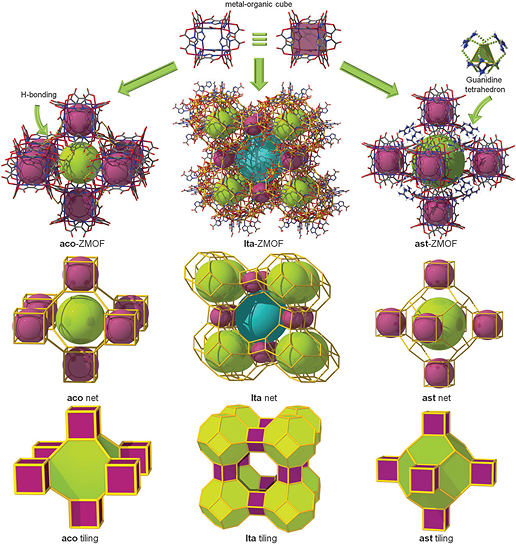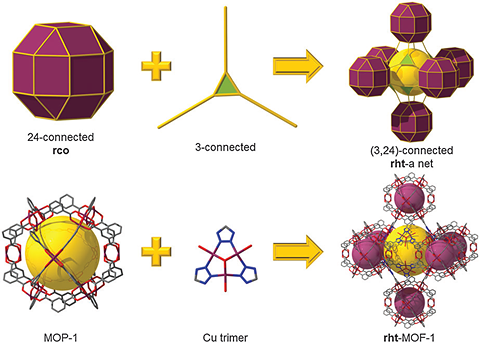Design Strategies: Supermolecular Building Block (SBB) Approach
.tmb-th1050x650.png?Culture=en&sfvrsn=8acea8b9_1)
Details
The ability to target nets that are exclusive for a combination of building blocks presents greater potential toward prediction, design, and synthesis of the resultant framework in crystal chemistry. Our group demonstrates this strategy by utilizing metal-organic polygons and polyhedra (MOPs), which can be externally functionalized, as supermolecular building blocks (SBBs) for nets that are unique.

Our SBB approach is also ideal for nets where the vertex figures indicate the need for high connectivity. Indeed, since simple MBBs with connectivity of 8 or greater are often too intricate to systematically obtain by means of simple organic ligands or multinuclear clusters, such complex structures can be more easily designed by utilizing SBBs with a high degree of symmetry and connectivity; that is, enhanced directional and structural information is already built in. In principle, there is a degree of predictability in such a strategy that is not present with basic MBBs and novel structures can be targeted.
Using this strategy, our group focuses on generating blueprint nets to target MOF platforms for applications. Our ideal blueprint starts with a net that: 1) is singular, exclusive for the assembly of given building units; 2) preferably, encloses polyhedral cavities with 3D interconnecting channels; and 3) is not susceptible to self-interpenetration upon net expansion and/or decoration. This confluence of traits into one material is quite rare; nonetheless, edge-transitive nets (i.e., one kind of edge) typically serve as suitable targets in crystal chemistry, and, thus, are a prime source to ascertain singular nets for the rational construction (top-down design) of MOFs. Our group has found that, often, the higher the connectivity of at least one vertex, the more limited the overall number of potential nets. Analysis of high-connectivity, edge-transitive nets revealed an exceptional net, rht, which met all of our requisite criteria. The rht net is singular for the assembly of 24-connected vertices (rhombicuboctahedral (rco) vertex figure) and 3-connected vertices (triangular vertex figure). Though triangular MBBs are common in MOF chemistry, 24-connected inorganic MBBs are relatively unknown and organic molecules with higher connectivity often present with diminished solubility. Our SBB approach is ideal, utilizing externally functionalized MOPs as SBBs, to access the high connectivity rco necessary for constructing rht-MOFs.

Related
Publications
- MOFs
- Design
- SBB
- SBL
- Pillaring
- MOFs
- Design
- Rare earth
- Lanthanide
- Catalysis
- Hydrocarbon
- Copper
- Sorption
- Separation
- Controlled porosity
- Hybrid materials
- Metal-organic frameworks
- Reticular chemistry
- Supermolecular building blocks
- Building blocks
- Metal Organic Framework
- Crystal chemistry
- Functional materials
- Copper
- Hydrogen
- Ligand
- metal
- metal organic polyhedra
- Nitrogen
- organic compound
- Unclassified drug
- Adsorption
- Article
- Chemical structure
- crystal structure
- desorption
- heating
- Porosity
- reaction analysis
- Structure analysis
- Synthesis
- X ray pow
- Adsorption
- Chemical structure
- cross linking
- crystal
- crystal structure
- geometry
- reaction analysis
- Structure analysis
- supermolecular building block
- Synthesis
- Isophthalate
- cobalt
- dicarboxylic acid derivative
- nickel